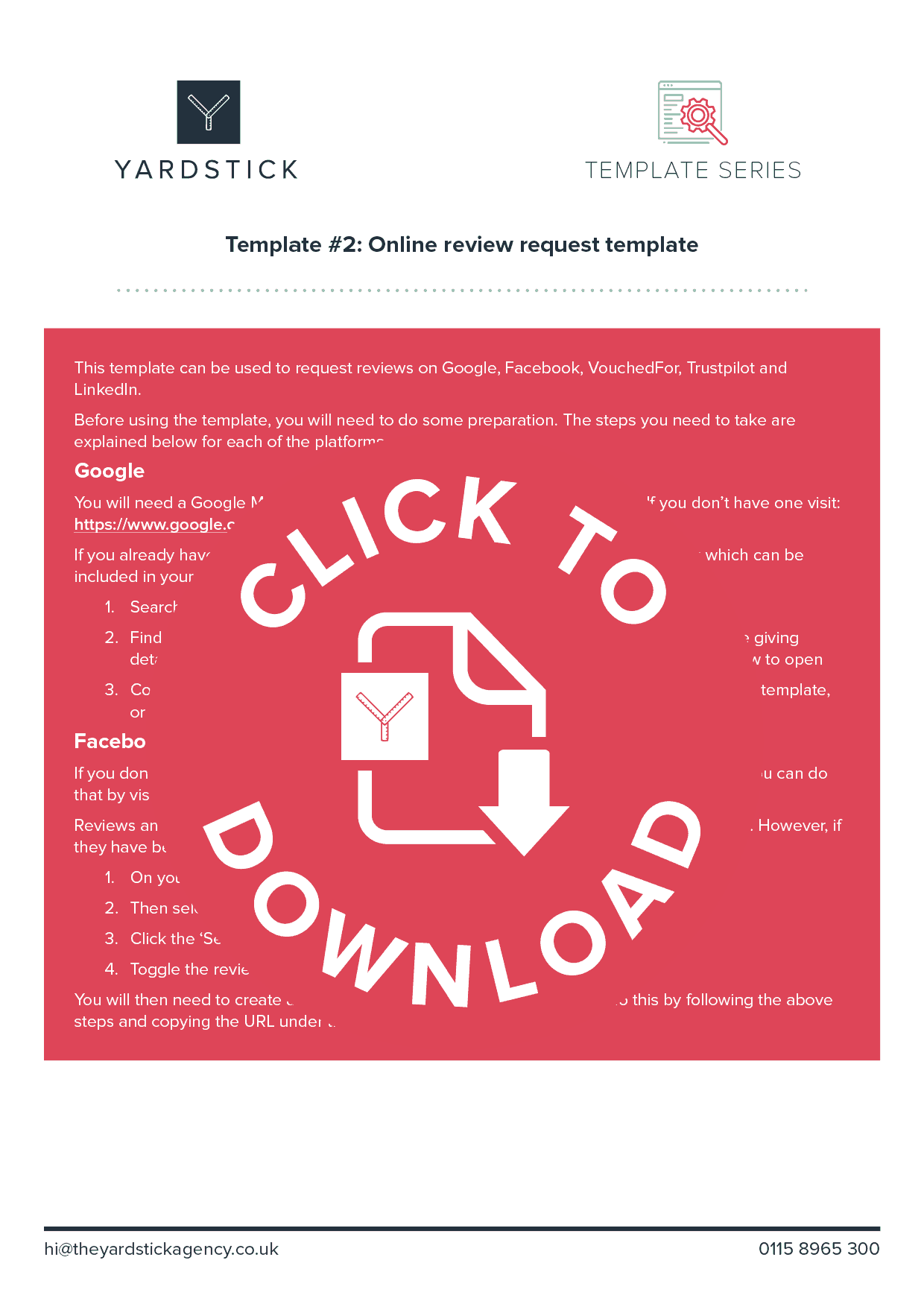 We talk endlessly about the importance of collecting social proof.
We talk endlessly about the importance of collecting social proof.
It’s the implementation though which turns a great idea into reality, and we know some firms struggle to collect reviews. If you’re one of those firms, or you haven’t started yet, we’ve put together this guide. In it we’ll:
- Explain why reviews and ratings are important
- Review the key platforms
- Recommend the platforms you should use
- Show you a proven process to collect ratings and reviews
Finally, we’ll give you a free template which will help you to implement our recommended process.
There’s a lot to digest, so we expect you will want to revisit this blog regularly or pass it on to a member of your team to implement. Naturally, if you need our help, we’re always here for you. Just email hi@theyardstickagency.co.uk or call us on 0115 8965 300.
Right. Sitting comfortably? Let’s begin.
Why are ratings and reviews so important?
Social proof takes many forms, including:
- Qualifications
- Accreditations
- Awards
- Press mentions
- Social media shares and likes
The most powerful of these is the client-led social proof, which demonstrates the outcomes of your work. For most firms, their efforts to collect client-led social proof starts and ends with testimonials. However, more forward-thinking firms (with a little encouragement from the likes of us) are taking it to another level by using written case studies (ideally supported by a photo of the clients) or short films of clients telling their story.
You can see examples of the client stories on websites we’ve developed for Red Circle Financial Planning and Black Swan Financial Planning. Examples of videos can be seen on the TFP Financial Planning and Engage websites.
Forward-thinking firms are also using the results of client surveys as part of their social proof strategy, as well as online ratings and reviews which are vital for several reasons:
- When people carry out an online search for your brand (i.e. they’re searching for your business or yourself rather than a product or service), having been referred to you or encountered your business elsewhere, they’ll see the reviews. That generates a positive impression and improves the chances of them getting in touch.
- Online ratings and reviews can usually be embedded into your website and used elsewhere in your marketing.
- Reviews on trusted sites, especially Google Reviews where your target clients live close by, are a ranking factor. They help you to appear higher in the natural search results for key terms used by your target clients.
- Occasionally, a firm might get a poor review; it might be justified, it might be fake. Either way, it doesn’t look good. If you receive a poor review, your proactivity in previously collecting reviews from satisfied clients means you’re ahead of the game. It also demonstrates that the poor review isn’t indicative of your usual high standards.
- If shared with your team, ratings and reviews provide praise and validation for their work. Everyone likes to hear they are doing a good job!
An analysis of the available platforms
There are many platforms available to collect reviews. So, we’ve limited our analysis to only those we believe merit serious consideration.
Pros:
- Reviews appear on your Google My Business listing, catching the eye of someone searching for your brand.
- The reviews can be easily embedded into your website allowing the most up to date to be displayed.
- Google uses reviews as a ranking factor, particularly in local search.
- We’ve previously written about a simple and low-cost way to stand out online. That’s because very few other firms take Google reviews seriously. Our research shows that only 29.82% of firms have Google Reviews, and the majority of those only have a handful. To prove the point, head to Google right now and type in ‘financial adviser near me’ or financial planner near me’ then look at Google Places. How many firms have Google reviews? It’s probably not many. The more you collect, the more you will differentiate your business from others.
Cons:
- The reviewer needs a Google email address to be able to leave a review. This is often less of a problem than it sounds with many businesses using Gmail without you even knowing about it (we are one of them!) while other clients might be prepared to sign up for one just to leave you a review.
Facebook has recently made a change. In their own words, they have “retired their star rating. Now, when your customers want to write a review, they can choose to recommend or not recommend your page.”
Despite that, existing reviews and the rating continue to show in online searches, Google My Business listings and on Facebook itself.
Pros:
- It’s ubiquitous; research shows that nearly 40 million people in the UK use Facebook and almost eight million of those are over 55 (Source: Statista). That means there’s a high chance the person you’re asking will already have a Facebook account.
- Facebook reviews appear in your Google My Business listing giving potential clients a double dose of social proof.
- The reviews and recommendations can be easily embedded in your website allowing the most up to date to be displayed.
- If your focus is on attracting enquiries from people local to you, then Facebook can be a great way of embedding yourself and your business into the local online community.
- Recommendations in groups automatically appear on your Facebook page.
- Reviews will appear in the results following a brand search and, again, are a ranking factor.
Cons:
- If your business doesn’t have a Facebook page you will need to set one up and maintain it to collect reviews.
- The reviewer will need a Facebook account to leave a review. Although, with so many people using it, there’s a good chance they will already have an account.
VouchedFor
Pros:
- VouchedFor should be seen as a tool to manage your reputation, as well as one which will generate new enquiries. Over time, we’d expect the monthly fees to be more than covered by the enquiries it generates.
- The widget that VouchedFor provide can be used to attractively embed reviews into your website for both individual advisers/planners and your firm. Click here and scroll down the homepage on the Neligan Financial website to see this in action.
- VouchedFor provides other ways to ‘show off’ your reviews and client satisfaction, including Certificates of Excellence, email signatures and portfolios of your reviews.
- It also does an excellent job of showcasing the most highly rated advisers and planners. The most recent example of this was their Top-Rated Advisers supplement distributed earlier this year in The Times.
- The processes VouchedFor has for verifying the authenticity of reviews are impressively robust, giving both subscribers and consumers confidence that the reviews are a true reflection of the service delivered and received.
- Consumers don’t have to have an account to leave a review.
- The VouchedFor system allows you to send a bulk message to your clients. That’s useful when you’re starting out and want to give your profile an initial boost.
- The VouchedFor search algorithm includes factors such as the number of reviews and quality. Consequently, those who use it to collect social proof will benefit when it comes to new client enquiries.
- Reviews will appear in the results following a brand search and, again, are a ranking factor.
- VouchedFor profiles/reviews rank highly for both individual adviser name searches and firm name searches. This is important as often if a client refers a friend, the first thing they will do is type the adviser/planner’s name (not the firm name) into Google.
- Reviews on Google and Trustpilot can be imported into VouchedFor.
Cons:
- VouchedFor has a free membership level (useful while a new adviser/planner/firm is collecting reviews) but to unlock the benefits we’ve mentioned above, including enquiry generation, you need to be a paying subscriber. The cost is relatively low though and should more than pay for itself over time.
Trustpilot
Pros:
- Trustpilot is the largest dedicated rating and review site.
- Comparatively few financial advisers and planners use Trustpilot to collect ratings and reviews. Therefore, if a consumer uses it to search for advice, the field should be less crowded.
- Reviews will appear in the results following a brand search and, again, are a ranking factor.
- Trustpilot provides a range of free tools to help you build your reviews and show them off to potential and existing clients.
Cons:
- Compared to the other options, it isn’t cheap, with pricing plans starting at £149 per month (assuming the subscription is paid annually).
- Over recent months some of Trustpilot’s practices have attracted some negative publicity.
- To leave a review your client will need to create Trustpilot account, some will be happy to do this, others not.
Pros
- If your target clients use LinkedIn as one of their preferred social media channels, using it to collect ratings and reviews can make sense.
- Asking for reviews is straightforward.
Cons
- Your clients need to have a LinkedIn account to leave reviews (LinkedIn calls it a ‘recommendation’). If you’re targeting an older, perhaps retired, demographic, they are less likely to use LinkedIn than other platforms we’ve suggested.
- Only an individual can be reviewed, not a business.
- There’s no option to rate the service received, therefore, it’s hard for consumers to quickly compare firms.
- The reviews are somewhat hidden towards the end of your profile page.
Which platform should you use?
We recommend that you select two platforms to collect ratings and reviews.
The first should always be Google. The way ratings are displayed following a brand search and the influence it has on rankings for other searches, especially those local to you, make it the obvious first choice.
However, not everyone has a Gmail address. You should, therefore, offer an alternative, and we recommend VouchedFor or Facebook.
The new enquiries VouchedFor will produce, plus their tools to help you manage your reputation, push it ahead of Facebook on our view. However, if Facebook is already core to your marketing or you’re looking to embed yourself into the local community, then that’s possibly a sensible support to Google.
How to ask your clients
You could just ask your clients and hope they leave a review. However, you’ll probably be wasting your time; as well-intentioned as your clients might be, life gets in the way and the chances are they’ll forget.
Here’s what we suggest instead:
- After a new client has been engaged, or at the next period review, the adviser/planner asks the client if they would be happy to leave a review.
- Assuming the client is happy to do so, the verbal request is followed up by an email sent by a member of the adviser/planner’s support team. Clearly, if you’re a sole practitioner you will have to do this yourself.
To make your life easier we’ve produced a series of templates for each of the rating platforms we reviewed earlier, which can be used/adapted when you email clients. Click here to download them.
When the client leaves a review, you should do three things:
- Thank them by replying to it and by sending them an email.
- Share the review with your team; this validates the work that they are doing for the client and creates peer pressure in multi-adviser/planner firms for others to pull their weight and collect reviews too.
- Share reviews with your other clients. Your newsletter is the ideal way of doing this. Add a section which showcases your Google, VouchedFor, Facebook or Trustpilot rating and update each edition with the latest score and comments. Not only will this provide further validation for why they work with you, but it’ll also demonstrate you’re a safe pair of hands for them to refer their friends and family too.
Free resources
As we said, we’ve created a template email that you can adapt and then send to clients. It’s free and there’s no need to provide us with any information to access it.
You can download it by clicking here.
Next step
If you’ve got this far you probably don’t need convincing about the importance of collecting online ratings and reviews.
So, here’s what you should do:
- Decide which members of your team will take ownership of the project.
- Ensure you have the whole team’s support, from the most senior management to advisers/planners, paraplanners and administrators.
- Agree which platforms you will use to collect the reviews.
- Embed the email request for reviews into your existing processes.
- Agree who will respond to reviews and email a ‘thank you’ to clients.
If you have any questions, queries or feedback about anything we’ve said, or would like our help developing your social proof, please get in touch.
Or email hi@theyardstickagency.co.uk or call us on 0115 8965 300.



